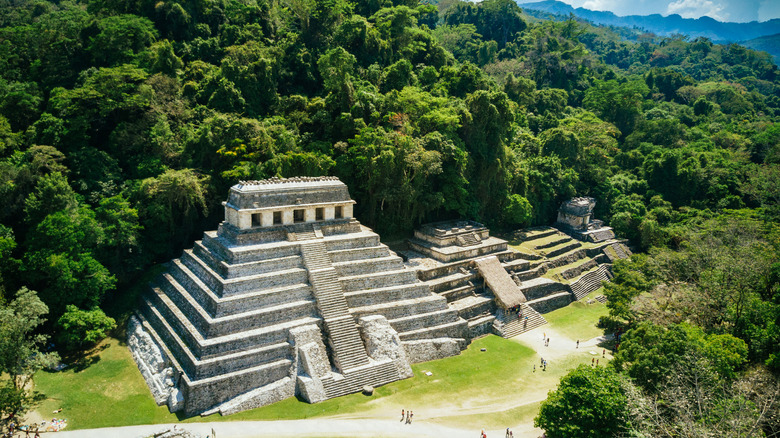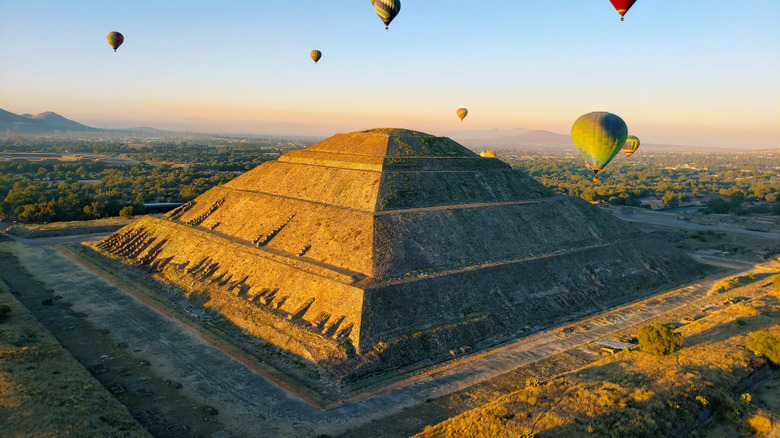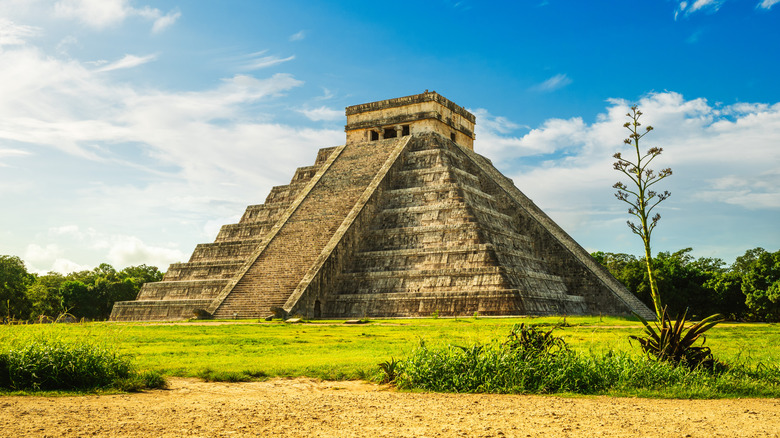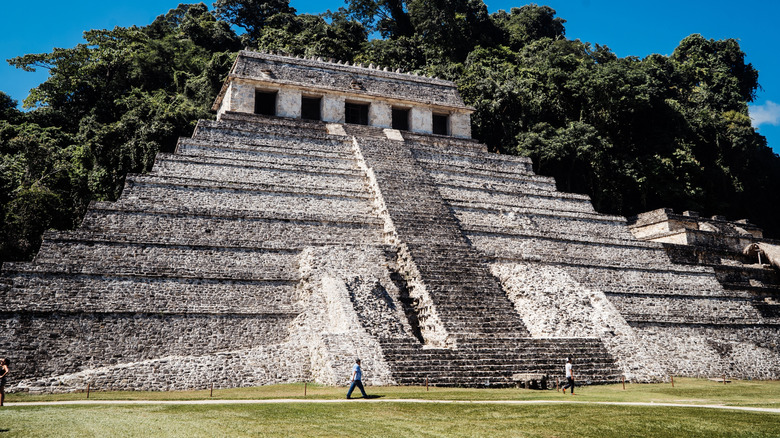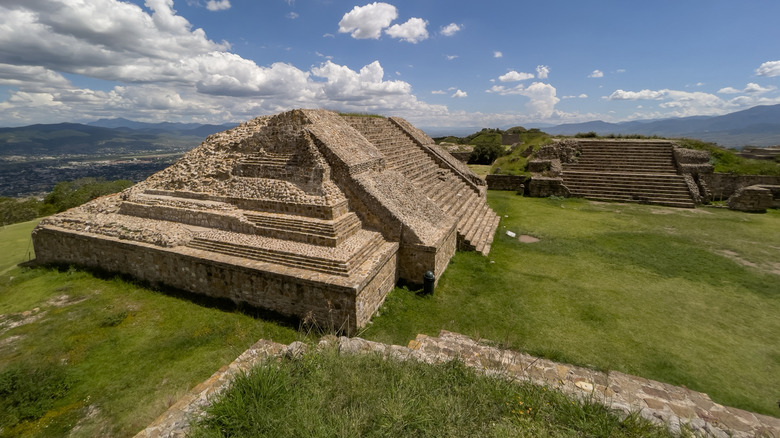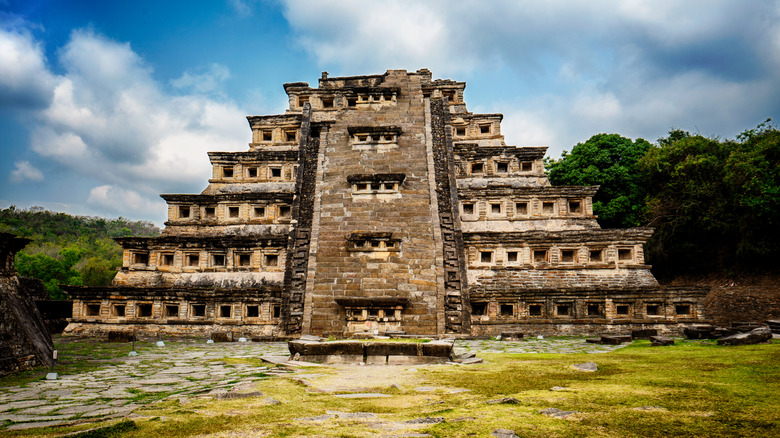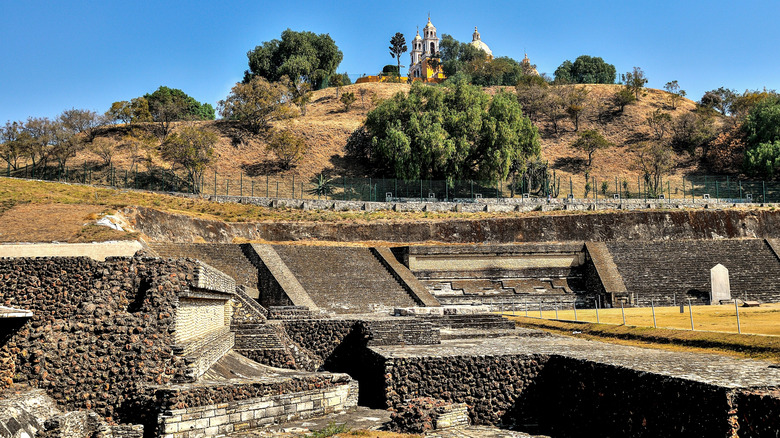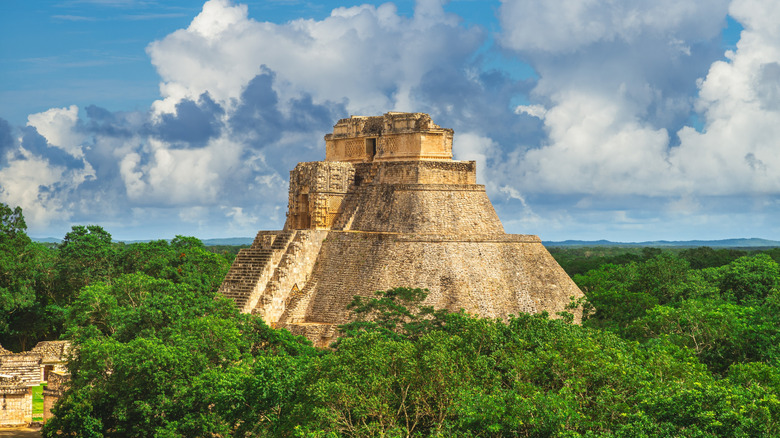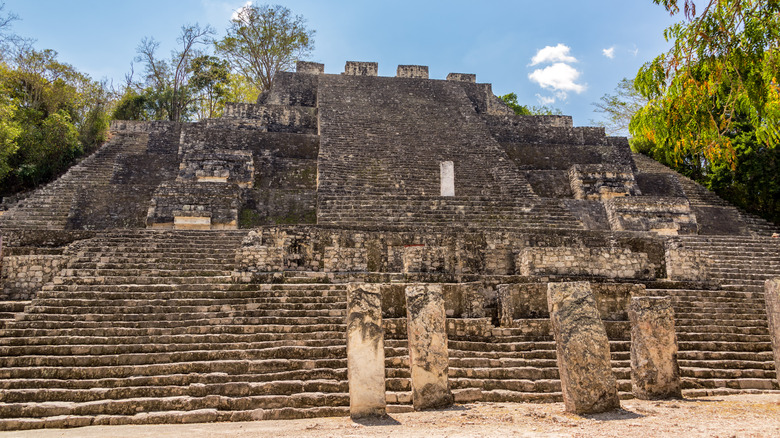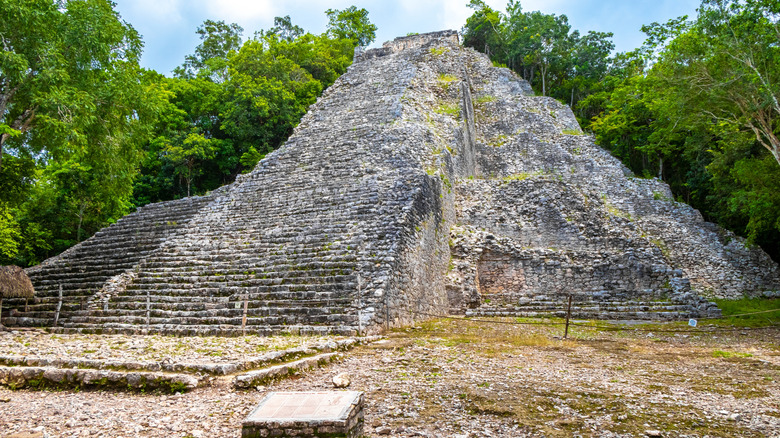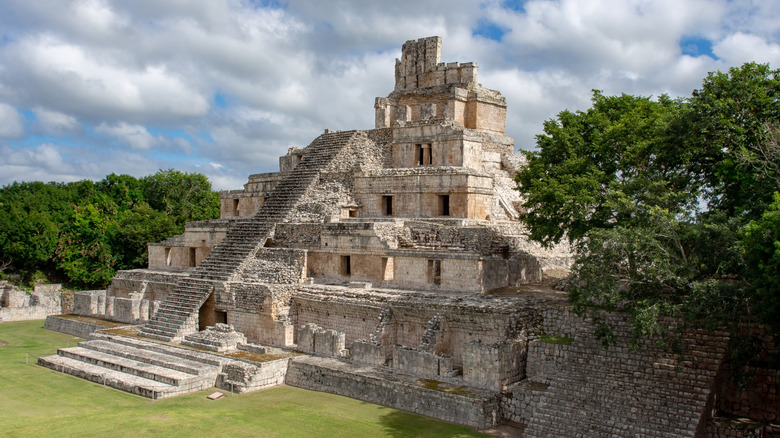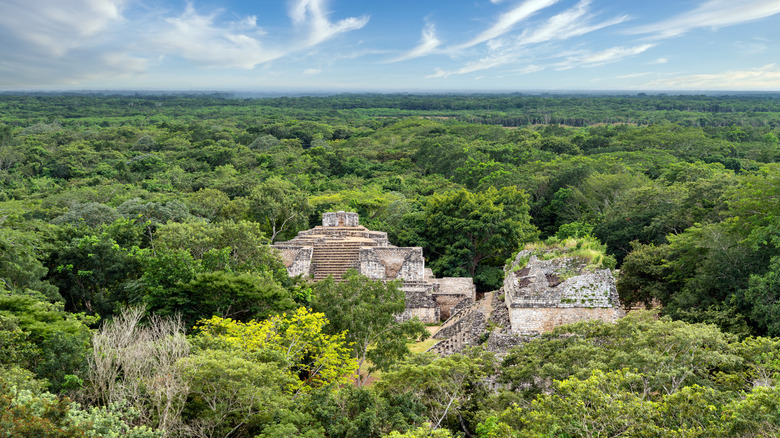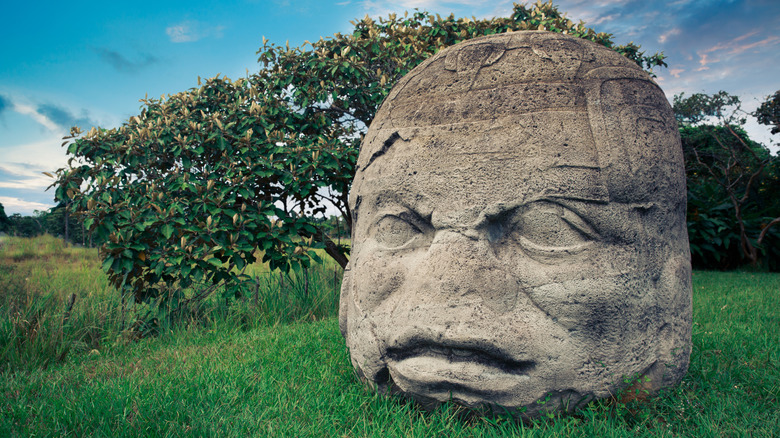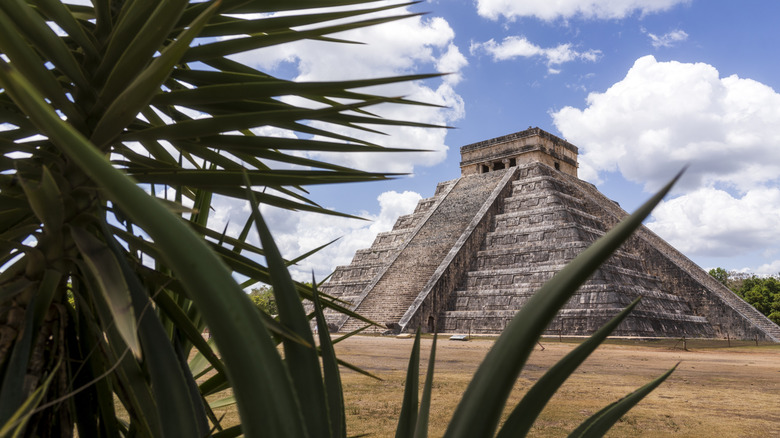The Best Pyramids In Mexico Worth Visiting
From exploring Mexico's diverse cities and magic towns, to its exciting food scene and incredible nature, Mexico is one of the best vacation destinations out there. Plus, it has an absolutely fascinating history, stretching back thousands of years. While you could certainly get a dose of history at any number of Mexico's excellent museums, there's no better way to immerse yourself into Mexican history and culture than by going straight to the source.
Luckily, Mexico has a number of remaining ancient ruins scattered across the country, and are the ultimate bucket-list addition to any Mexico itinerary. We've rounded up the very best pyramids in Mexico, based on our personal experience as well as research and the experience of other travelers. We made sure to include some well-known spots, as well as some hidden gems, if you'd prefer to avoid the crowds.
Pyramid of the Sun and Pyramid of the Moon, Teotihuacán (state of México)
Some of Mexico's most impressive pyramids are right outside of Mexico City. Teotihuacán was once among Mesoamerica's most powerful cities, and one of the largest cities in the world. At its peak, around 500 C.E., it was home to an estimated 200,000 people. A couple centuries later, the city began to go into decline, although years later, it became an important site for Aztec pilgrims.
Of the eight-square-mile complex including apartment complexes, plazas, palaces, and temples, its most impressive structure is by far the Pyramid of the Sun. The largest structure of its kind in the entire Western Hemisphere,the pyramid is accompanied by the Pyramid of the Moon, which is Teotihuacán's second largest structure.Both can be found along what is known as the Avenue of the Dead — here, you can find the Ciudadela, or "Citadel," a large square courtyard also home to the Temple of Quetzalcóatl, "the Feathered Serpent," which is decorated with stone snake heads.Typically an hour-and-a-half to two hours outside of Mexico City, it's possible to visit Teotihuacán either as part of a tour or on your own.
Castillo de Kukulcán, Chichén Itzá (Yucatan)
Among Mexico's numerous pyramids and archaeological sites, one of its most visited is none other than Chichén Itzá, located in the Yucatán Peninsula and one of UNESCO's New Seven Wonders of the World. Among its two sections, Old Chichén and Chichén Itzá, there are 26 different Maya ruins at this legendary destination. Its most noteworthy, however, is El Castillo, also known as Kukulkan Pyramid. The impressive 82-foot-high structure is actually a Maya calendar. Its numerous terraces, steps, and panels, all correspond to the calendar's months, days, and years. Its history serving as a calendar becomes even more apparent during the spring and autumn equinoxes, when the light and shadows creates an illusion of a serpent descending down El Castillo's stairs.
Keep in mind that visitors are not permitted to ascend the pyramid or enter its passageway. While here, don't skip a visit to Chichén Itzá's other important structures, including El Caracol or The Observatory, The Temple of The Warriors, and the Mayan Ball Game. While visiting Chichén Itzá with a guide will offer you far more insight, it's also possible to go on your own and appreciate the awe-inspiring scenery.
Pyramid of the Inscriptions, Palenque (Chiapas)
One of the best spots for Maya architecture is tucked away in the jungle of Chiapas. Hundreds of structures make up the ancient ruins known as Palenque, but only one area has been fully excavated. Home to original sculpted stone and stucco, painted murals, and one the longest hieroglyphic text inscriptions of the ancient Maya, Palenque is full of impressive sites to see. What you can't miss, however, is the Templo de las Inscripciones, which is considered one of the most notable burial monuments in the Americas. As one of the largest and best-preserved structures in Palenque, the eight-level Pyramid of the Inscriptions is known not only for its hieroglyphics detailing the history of Palenque and the temple, but the crypt that was discovered underneath the temple in the 1950s, likely belonging to a 7th century ruler (unfortunately the tomb is currently closed to visitors to protect the murals from damage).Nearby, El Palacio and Grupo de las Cruces, made up of three pyramid-shaped temples, add to the site's scenery.
To enter Parque Nacional Palenque, the national park where the ruins are located, there is a separate admissions fee of 105 Mexican pesos, apart from the 95 pesos to enter the ruins. Try to visit earlier in the morning to avoid both the crowds and the heat. You also may find that at this time, the temples and surrounding forests are blanketed in mist, making them even more magical.
Monte Albán Pyramids (Oaxaca)
Just 20 minutes away fromthe vibrant city of Oaxaca, Monte Albán is one of Mexico's most iconic historic sites. The former Zapotec community was founded in the sixth century BC, and was occupied for roughly 1,300 years, before it was mysteriously abandoned. Considered Oaxaca's most significant archaeological site, unlike at some other pyramids across the country, here, you can climb the pyramid's stairs, allowing you to really appreciate both the scale and the gorgeous scenery. It's also relatively uncrowded, compared to other famous pyramids like in the Yucatan's Chichén Itzá.
Monte Albán's remaining terraces, pyramids, and canals stretch across four square miles, so expect to spend two or three hours here. Admission costs 90 Mexican pesos, and arriving first thing in the morning is best to avoid both crowds and the worst of the heat. If possible, try to avoid visiting on a Sunday, when Mexican residents get into the site for free, meaning it will likely be more crowded. "This is such a spectacular site," said one reviewer on Tripadvisor. "We arrived at 8:30 am and stayed for about 2 hours. We visited on a weekday and basically had it to ourselves."
Pyramid of the Niches, El Tajín (Veracruz)
Nestled within Veracruz's jungles is El Tajín, an ancient civilization which likely dates back to 800 and 1200 — after the fall of Teotihuacan, and before the rise of the Aztec empire, if you're keeping track. Once a powerhouse in Mesoamerica, and a prominent trade center with remarkable cultural influence across the region, it's believed that between 15,000 and 20,000 people once called El Tajín home.As a relatively remote destination, El Tajín is somehow still relatively under-the-radar, and generally uncrowded, which is always a plus.
While here, marvel at everything from small, grass-covered pyramids, to structures that have only been partially excavated, to the towering behemoth, Pyramid of the Niche, which stands at over 65 feet tall. Made up of seven stepped terraces, and stacked rows of stone blocks creating niches, it's likely that the building was once used as an astronomical calendar. "What a beautiful site, not so crowded in a peaceful surrounding," said a Tripadvisor reviewer. "Just one word, 'amazing,' and definitely to be put on your list of sites to see in Mexico."
Great Pyramid of Cholula (Puebla)
The cornerstone of one of Mexico's best magic towns, Cholula, the Great Pyramid is a must for any visitor to the Puebla area. The pyramid, also known as Tlachihualtepetl, is said to have the largest base of any pyramid in the world, and is nearly twice the size of Egypt's Great Pyramid of Giza when it comes to volume. The pyramid was likely first built around 300 B.C.E., and was once a sacred site dedicated to the Aztec god of rain and wind. At its height, Cholula was a large city with an estimated 60,000 to 100,000 people, and was a pilgrimage site for various other Indigenous groups.
Unlike in some other archaeological sites across Mexico, there aren't other pyramids or ancient structures to explore in the area — but is instead situated right underneath a picturesque tangerine-colored church that was constructed in 1574 by the Spanish. It's well worth making the short hike up the pyramid to where the church is. From the top, the views are unforgettable. To explore the ruins, it costs 95 Mexican pesos, which includes admission into the pyramid's tunnels as well as an accompanying museum, which offers additional background information as well as a reproduction of the pyramid, giving you a better sense of its true scale back in its heyday.
Pyramid of the Magician, Uxmal (Yucatán)
This UNESCO World Heritage Site in the Yucatán is another must for anyone interested in history. Constructed in a distinct ornate and geometric style, Uxmal is known as one of the best examples of ancient Maya architectural sculpture. Once an important political capital as well as a important pilgrimage site, Uxmal was likely abandoned around the 10th century, before the Spaniards' arrival, but exact timing is unknown.
When entering the archaeological site, you'll immediately be greeted by the 100-foot Pyramid of the Magician. This pyramid was built in five different phases, with pyramids built on top of one another. Some other sites you won't want to miss here include the Pyramid of the Old Woman, the Nunnery Quadrangle (a name given to the site by the Spanish), and the ball court, just to name a few. "Uxmal was incredible," recounted one past visitor on Tripadvisor. "The absolutely inspiring nature of the Mayan pyramids is one that will leave you in awe. The carvings are pristine and the structures absolutely amazing. Well worth a visit."
Structure 2, Calakmul (Campeche)
Although there are a number of spectacular Maya sites throughout Mexico, arguably the most impressive is Structure 2, which is the highest and largest Maya structure. Located in the state of Campeche, one of the safest destinations in Mexico, there were once nine royal tombs here, and it's about 150 feet tall, thanks to centuries of building up the structure. You can even climb the pyramid here, unlike at some other sites — just be careful, the steps are steep. Structure 1 is the second-highest Maya building, and is also well worth a stop, as are other Calakmul sites like a ball court and Chiik Nahb Acropolis, which offers a fantastic view of Structure 2 along with housing amazing murals inside.
But despite that, Calakmul is vastly underrated. "The site is just amazing," said one visitor on Tripadvisor. "You really feel like an explorer because of the few tourists." Located in a remote area near Guatemala and away from any major tourist cities, it's more difficult to visit and far off the tourist radar. It's so under-the-radar, that it supposedly only gets around 12 visitors a day, according to the travel blog, Expert Vagabond. However, according to recent visitors, there is now a paved road, meaning the drive is significantly easier, and there is also a new train route, meaning this fantastic destination may not stay a hidden gem for much longer.
Nohoch Mul Pyramid, Cobá (Quintana Roo)
The Yucatán is home to a number of amazing destinations, from vibrant pink lagoons to fascinating Maya sites, and Cobá, located in Quintana Roo, is no exception. Less visited than sites like Chichen Itza, Cobá. which was likely first settled around 100 BC and reached its peak during from 600 to 800 AD, is not to be missed. Since it hasn't been fully excavated, the site is intertwined with nature, and you feel as if you're wandering through a forest and stumbling upon pieces of ancient history.
Among Cobá's extensive network of 6,000 structures, spread across 31 square miles, the Nohoch Mul pyramid is the star of the show, and the sole pyramid that can be climbed here. It's also the highest structure in the state of Quintana Roo, standing at 138 feet tall. It takes 120 steps to reach the top, but you'll be rewarded with gorgeous jungle views. Cobá is aso distinguished by its stone roads known as sacbeob. Here, you can find the largest example across the Maya world. Of its 50 roadways that have been discovered, 16 are open to the public. One even connects Nohoch Mul to the famous Chichen Itzá in Yucatán.
Temple of the Five Floors, Edzná (Campeche)
Just an hour away from the town Campeche, Edzná is another ancient site that doesn't get a lot of attention from travelers, but that doesn't mean it's any less special than more well-known destinations. At its height between 200 and 1000 C.E., about 25,000 people lived in Edzná. Oddly enough, Edzná's center is structured similarly to Teotihuacan near Mexico City — which was constructed in a completely different time period and region, by a completely different group of people. The area is also home to an array of canals and reservoirs, and throughout its four main complexes, you can find palaces, residences, and sacbeob (white stone roads).
Within the massive Grand Plaza area, find highlights like Nohoch Na, a 443-foot-long platform base, and the iconic Temple of the Five Floors, a five-tiered pyramid that once was as residence for Edzná's rulers. "It is simply amazing to see the mastery the Mayans had of complex architecture, and how different it is from other Mayan sites we've visited," said one previous visitor on Tripadvisor. "Really an amazing secret place to visit, a definite go!"
El Torre, Ek Balam (Yucatán)
Although not much of Ek Balam's history is known, this Maya city dates back to 300 B.C.E., and at its peak, housed about 20,000 people between 770 and 840 C.E.. Today, about one square mile can be explored by the public, and it's a must for visitors to the nearby Riviera Maya, especially for its distinct level of artistry. El Torre, or The Tower, is one of the Yucatán's largest Maya structures, at 100 feet high. Plus, it has remarkably detailed decorations along the building, made from stucco and limestone. The pyramid is home to the tomb of Ukil-Kan-Lek-Tok, Ek Balam's leader from around 800 C.E. The tomb also houses highly detailed sculptures, wall paintings, and murals.
Although it's a bit of a difficult climb, visitors are allowed to ascend the steep staircases of El Torre, as is the case for the majority of other buildings throughout Ek Balam. Apart from El Torre, there are a number of other breathtaking structures, and ceremonial features, such as a ball court. This magical archaeological site is truly a must in the Yucatán. Admission is 534 pesos, and cash-only. "Views and history were unbelievable, like being placed back in time," said one past visitor on Tripadvisor. "I would go a thousand times over."
La Venta (Tabasco)
All of these pyramids go far back in history, but few are quite as ancient as the La Venta, which was inhabited by the Olmecs from 800 to 400 B.C.E. The Olmecs likely formed around 1500 B.C.E., and although much is known about their culture, they are said to have created the Mesoamerican ball game which was popularized across Mexico and Central America, along with possibly introducing pyramids to the country. Within La Venta, its pyramids are said to be the first in modern-day Mexico.
Unfortunately, many of the structures in La Venta were damaged by the petroleum industry, and as a result, the best way to see many of the sculptures, such as the recognizable basalt Olmec heads, and other artifacts, are at Parque Museo La Venta in Villahermosa, Tabasco. At the actual archaeological site, many of the sculptures are replicas, since they have been moved to the park for protection. Admission to the park is just 40 Mexican pesos for foreigners. Although the actual site isn't overall the most impressive, you will get to see the original pyramids, such as Edificio C-1, the nearly 100-foot rounded pyramid made from clay and sand. Past visitors just say to be sure to bring lots of mosquito repellant, if you do make the trek.
Methodology
We used a significant amount of research both to gather this list of recommendations, and to verify all of our factual information regarding the history of the pyramids and how to visit. We utilized travel publications, destination sites, and Tripadvisor reviews to ensure that each of the pyramids we included are worth visiting. We also used personal experience to make our selections.
